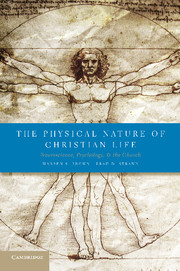Book contents
- Frontmatter
- Contents
- Acknowledgments
- 1 Bodies or Souls?
- Part I Human Nature as Physical
- 2 Christian History and the Two-Part Person
- 3 Embodied Soulishness
- Part II The Formation of Persons: Retrospect and Prospect
- Part III Emodied Christian Life and The Church: Retrospect and Prospect
- Selected Resources
- Index
- References
3 - Embodied Soulishness
Published online by Cambridge University Press: 05 July 2012
- Frontmatter
- Contents
- Acknowledgments
- 1 Bodies or Souls?
- Part I Human Nature as Physical
- 2 Christian History and the Two-Part Person
- 3 Embodied Soulishness
- Part II The Formation of Persons: Retrospect and Prospect
- Part III Emodied Christian Life and The Church: Retrospect and Prospect
- Selected Resources
- Index
- References
Summary
THE VISIONS OF SISTER JOHN
Sister John opened a fresh notebook and began to write. Adoration welled up through the pain, closing of the gap between lover and Beloved. The force of his presence curved eternity in on itself; it was not her love rising after all, but his love pulling her toward him. She fell upward into brilliance, where all suffering was released.
In the fire of his embrace, all that was her ceased to exist. Only what was God remained.
[some days later, Sister John interacting with the Mother Superior]
Dear God, help me bear this –
“Are you sure you’re all right, dear? You look very pale.”
“Forgive me, Mother . . .”
The notebook fell off her lap.
have mercy
She was sure the blood vessels in her head would give way. . . ..
Her mind fractured under the pressure. She splintered like a broken glass . . . she was sure this had to be death, it had to be the end of everything, then her suffering blinked off.
an invisible sun
a shock wave of pure Being
swept my pain away, swept everything away
until all that was left was God.
[the diagnosis from Sister John’s physician]
“The EEG showed that you have an epileptic disorder, but so far the seizure activity is localized in the temporal-lobe area of the brain. That’s good – it’s kept you from having grand-mal attacks, the kind that spread across the whole brain and cause convulsions. Temporal-lobe seizures tend to be more psychological.”
From Salzman, Lying AwakeVISIONS AND THE BRAIN
Mark Salzman, in his novel Lying Awake, tells the story of Sister John of the Cross, a nun in a Carmelite convent in Los Angeles. As described in this passage, Sister John experiences powerful and overwhelming religious visions. These visions came to mark her as an important spiritual resource, both within and outside her community – perhaps a saint. However, as the story progresses, it becomes clear that her visions are a product of epileptic seizures. The dilemma that provides the drama within Salzman’s narrative revolves around whether to undergo a surgery that will “cure” the seizures, but will also eliminate her wonderful and luminous spiritual visions.
- Type
- Chapter
- Information
- The Physical Nature of Christian LifeNeuroscience, Psychology, and the Church, pp. 28 - 48Publisher: Cambridge University PressPrint publication year: 2012



